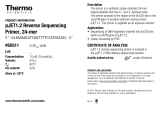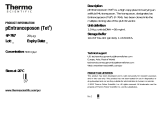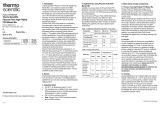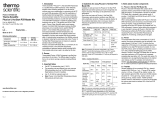Page is loading ...

PRODUCT INFORMATION
Thermo Scientific™ MuSeek
Library Preparation Kit for Ion Torrent™
#K1331
For 10 rxns
Lot ________
Exp. __
Store below -70°C before opening
For barcoded DNA fragment library generation use with:
Thermo Scientific™ MuSeek Barcode Set 1, Ion Torrent™ compatible
(Cat. No. #K1541)
www.thermoscientific.com/onebio

2
CONTENTS page
COMPONENTS OF THE KIT ............................................................ 3
STORAGE ......................................................................................... 3
DESCRIPTION .................................................................................. 4
TECHNOLOGY OVERVIEW ............................................................. 4
PREPARATION OF BARCODED LIBRARIES .................................. 7
IMPORTANT NOTES ........................................................................ 7
PROTOCOL .................................................................................... 10
A. Fragmentation reaction ....................................................... 10
B. Adaptor addition ................................................................. 12
C. Size selection and library quantification .............................. 14
D. Sequencing ........................................................................ 16
TROUBLESHOOTING ..................................................................... 17

3
COMPONENTS OF THE KIT
Component
Cap color
Amount
Important Notes
MuSeek Enzyme Mix
Red
10 µL
Store below -70 °C. Avoid
repeated freeze-thaw cycles.
MuSeek Fragmentation
Reaction Buffer
Yellow
100 µL
MuSeek Stop Solution
Orange
30 µL
Contains SDS, store at room
temperature.
Control DNA
White
4 µL
50 ng/µL cI857 Sam7 Lambda
DNA, size 48.5 kb.
MuSeek Adaptor Addition
Primer Mix
Purple
40 µL
MuSeek Adaptor Addition
Reaction Buffer
Green
1 mL
Contains 2x reaction buffer with
dNTPs.
Phusion™ Hot Start II
High-Fidelity DNA Polymerase
Blue
40 µL
MuSeek Sequencing Primer
White
300 µL
After receiving this kit, we
recommend you to place the
MuSeek Sequencing Primer vial
into the same box with your other
sequencing reaction reagents
(into your Ion Sequencing Kit
box).
This primer must be
used ONLY when sequencing
non-barcoded MuSeek
libraries. For barcoded MuSeek
libraries use original
sequencing primer, provided in
the Ion Sequencing Kit.
STORAGE
The kit is shipped on dry ice. Upon arrival, open the kit and place MuSeek Enzyme Mix for
storage below -70 °C, avoid repeated freeze-thaw cycles. The Stop Solution can be stored at
room temperature, and the remaining kit components at -20 °C.

4
DESCRIPTION
Thermo Scientific™ MuSeek Library Preparation Kit for Ion Torrent™
*
is designed for
generation of high‐quality genomic DNA libraries for sequencing with the Ion Personal
Genome Machine™ (PGM™) and Ion Proton™ systems. The fast protocol utilizes MuA
transposase enzyme, which catalyzes simultaneous fragmentation of double-stranded target
DNA and tagging the fragment ends with transposon DNA. In a subsequent PCR step the
platform-specific adaptors are added using a robust and accurate Thermo Scientific Phusion™
High-Fidelity DNA polymerase. Starting with only 100 ng of the sample the same protocol can
be used to generate 100-400 bp insert libraries.
The kit contains components sufficient for 10 fragmentation and the subsequent adaptor-
addition polymerase chain reactions. The kit also contains a MuA-specific sequencing primer
that is required in the PGM sequencing runs when non-barcoded libraries are prepared by this
method.
Figure 1. Overview of the workflow.
TECHNOLOGY OVERVIEW
MuA transposase enzyme is a 75 kDa protein originating from bacteriophage Mu, and is
produced as a recombinant protein in E. coli. Under suitable conditions, MuA transposase
forms a homotetrameric complex with two 50 bp double-stranded transposon DNA ends that
contain a specific MuA binding sequence. After the fragmentation reaction, the ends of target
DNA are tagged with transposon sequences. PGM-specific adaptors are added to the
fragments in a subsequent adaptor-addition reaction. First, the 3'-ends of the fragmented
target DNA are elongated over the 5 nt gaps generated during the transposition reaction and
further extended into transposon sequences. In the initial cycles of consecutive PCR the first
16 nt of the adaptor 3'-ends hybridize to transposon sequences in tagged DNA fragments. In
later PCR cycles the fragments are amplified using a pair of external primers (Figure 2).
*
Patent pending.

5
Figure 2. MuA transposase complex simultaneously fragments input DNA and tags the fragments. In a
subsequent PCR, adaptor sequences are added.

6
Table 1. Sequences of the primers and transposon ends:
Name
Sequence
MuSeek/A
5’-CCATCTCATCCCTGCGTGTCTTCGTGCGTCAGTTCA-3’
MuSeek/A
(1-16)
barcoded
primer*
5’-CCATCTCATCCCTGCGTGTCTCCGACTCAGbarcode 1-16TTCGTGCGTCAGTTCA-3’
MuSeek/P1
5’-CCACTACGCCTCCGCTTTCCTCTCTATGGGCAGTCGGTGATTTCGTGCGTCAGTTCA-3’
A’
5’-CCATCTCATCCCTGCGTGTC-3’
P1’
5’-CCACTACGCCTCCGCTTTCCTCTCTATG-3’
MuSeek
Sequencing
Primer
5’-CATCTCATCCCTGCGTGTCTTCGTGCG-3’
Transposon
end
5’-GTTTTCGCATTTATCGTGAAACGCTTTCGCGTTTTTCGTGCGTCAGTTCA-3’
3’-CAAAAGCGTAAATAGCACTTTGCGAAAGCGCAAAAAGCACGCAGTCAAGTCGT-5’
*The sequences of MuSeek barcoded adaptors are available at Ion Community website
http://ioncommunity.lifetechnologies.com.
Non-barcoded sequence structure:
5’-CCATCTCATCCCTGCGTGTCTTCGTGCGTCAGTTCA [ Target DNA ] TGAACTGACGCACGAAATCACC
GACTGCCCATAGAGAGGAAAGCGGAGGCGTAGTGG-3’
Barcoded sequence structure:
5’-CCATCTCATCCCTGCGTGTCTCCGACTCAG [ Barcode 1-16 ] TTCGTGCGTCAGTTCA [ Target DNA ]
TGAACTGACGCACGAAATCACCGACTGCCCATAGAGAGGAAAGCGGAGGCGTAGTGG-3’
Figure 3. Sequence structures of adaptor containing target DNA fragment (non-barcoded and
barcoded).
TCAG patch is a key sequence (four different bases) that is used for Ion Torrent instrument calibration. The
sequencing read starts after the key sequence, and if the fragment end is reached the read will enter the
TGAA… sequence of the transposon. The sequences corresponding to primer A´ and complementary to
primer P´ are shown in italics.

7
PREPARATION OF BARCODED LIBRARIES
The MuSeek Library Preparation Kit for Ion Torrent™ is compatible with generation of
barcoded DNA fragment libraries when used in combination with the MuSeek Barcode Set 1,
Ion Torrent™ compatible (Cat #K1541). The MuSeek Barcode Set 1, Ion Torrent™
compatible, provides 1-16 MuSeek Barcode Adaptor Primer Mixes, each allowing for addition
of a unique Ion Torrent PGM™-compatible barcode sequence. This enables researchers to
pool up to 16 fragment libraries prior to size-selection and emulsion PCR, and then conduct
multiplexed sequencing analysis.
Important! When constructing barcoded DNA fragment libraries, replace the MuSeek Adaptor
Addition Primer Mix from MuSeek Library preparation Kit for Ion Torrent™ with a
corresponding MuSeek Barcode Adapter Primer Mix 1-16 from the Thermo Scientific MuSeek
Barcode Set 1, Ion Torrent compatible (such as MuSeek Barcode Adapter Primer Mix 1). For
sequencing of barcoded DNA fragment libraries use ONLY the original Ion Torrent
sequencing primer. No sequence data will be generated using MuSeek Sequencing
Primer.
IMPORTANT NOTES
FOR SEQUENCING NON-BARCODED LIBRARIES GENERATED WITH THIS KIT,
USE ONLY THE MUSEEK SEQUENCING PRIMER PROVIDED WITH THIS KIT!
FOR SEQUENCING BARCODED LIBRARIES GENERATED WITH THIS KIT, USE
ONLY THE ORIGINAL SEQUENCING PRIMER PROVIDED IN THE LIFE TECHNOLOGIES
ION SEQUENCING KIT!
NO SEQUENCE DATA WILL BE GENERATED BY THE ION SEQUENCING
PLATFORMS IF THE INCORRECT PRIMER IS USED, AS THE PRIMER BINDING SITES
ARE DIFFERENT FOR NON-BARCODED AND BARCODED LIBRARIES.

8
Always check if the correct sequencing primer is used for non-barcoded and
barcoded libraries:
Generation of NON-
BARCODED DNA fragment
library
Generation of MuSeek
BARCODED DNA fragment library
Required Thermo
Scientific™
products
MuSeek Library Preparation
Kit for Ion Torrent
(Cat #K1331).
MuSeek Library Preparation Kit for
Ion Torrent (Cat #K1331).
AND
MuSeek Barcode Set 1, Ion
Torrent™ compatible (Cat #K1541).
Adaptor addition
primer mix required
MuSeek Adaptor Addition
Primer Mix, provided with the
MuSeek Library Preparation
Kit for Ion Torrent
(Cat #K1331).
MuSeek Barcode Adaptor Primer
Mix 1-16, provided with the MuSeek
Barcode Set 1, Ion Torrent™
compatible (Cat #K1541).
Sequencing primer
required
MUSEEK SEQUENCING
PRIMER, provided with the
MuSeek Library Preparation
Kit for Ion Torrent
(Cat #K1331).
SEQUENCING PRIMER,
PROVIDED IN THE ION
SEQUENCING KIT.
Additional required reagents not provided with the kit:
Agencourt® AMPure® XP PCR Purification system (Beckman Coulter, Inc., Cat #A63880,
#A63881, #A63882)
70% ethanol (required for bead purification)
Size selection equipment [such as E-Gel® (Life Technologies, Inc.) system]
For preparation of barcoded NGS library, a Thermo Scientific MuSeek Barcode Set 1 (Cat
#K1541) is required.
Magnetic particle processing rack

9
Input DNA requirements and general recommendations:
The kit is designed to be used with 100 ng of high‐quality genomic DNA dissolved in
nuclease-free water, 10 mM Tris, pH 7.5-8.5 or TE buffer (10 mM Tris-Cl, pH 8.0,
1 mM EDTA ). The DNA samples must be free of contaminating proteins, RNA, organic
solvents and salts. For samples with unknown DNA quality, repurification of DNA is highly
recommended. The best DNA quality is achieved after sample purification using commercial
DNA purification kits, like Thermo Scientific GeneJET Genomic DNA Purification Kit
(Cat. #K0721, #K0722).
For construction of NGS library from PCR amplicons in fragmentation reaction do not use
PCR products shorter than 300 bp. Due to intrinsic features of the transposon technology a
~50 bp drop off is expected in sequencing coverage from each distal end of the amplicon
sequence. This can be averted by designing your amplicons to be ~100 bases larger than
the desired sequencing insert.
Control DNA is provided in the kit for introductory use of the reagents prior to using own
target DNA samples. Use 100 ng (2 μL) of the Control DNA supplied in the kit, and then
follow the instructions described below.
Use good laboratory practices to minimize cross‐contamination of products. Where
possible, perform library construction in a separate area or room.
Thaw frozen reagents on ice before use, and keep them on ice until ready to use. Minimize
the time outside of the below -70 °C freezer for the MuSeek Enzyme Mix.
Mix reagents thoroughly before use by vortexing or flicking the tube, especially if frozen and
thawed.
For optimal results always prepare a fresh 70% solution before starting the purification
procedure (70% ethanol is hygroscopic).

10
PROTOCOL
A. Fragmentation reaction
Note: Always keep the MuSeek Enzyme Mix on ice when preparing the reactions and
minimize handling times outside of the -70 °C freezer. Use 100 ng of high-quality gDNA
dissolved in nuclease-free water, 10 mM Tris, pH 7.5-8.5 or TE buffer (10 mM Tris-Cl, pH 8.0,
1 mM EDTA ).
1. Pipet all the reagents, except for MuSeek Enzyme Mix, in the given order into a 0.5 mL
thin-wall tube. Keep the mixture on ice. Mix the contents thoroughly by vortexing briefly
(3-5 seconds) and spin down to the bottom of the tube.
Component
Volume
Nuclease-free Water
Add to 30.0 µL
MuSeek Fragmentation Reaction Buffer
10.0 µL
gDNA
X µL (100 ng)
MuSeek Enzyme Mix
1.0 µL
Total
30.0 µL
2. Note: Important step! For successful DNA fragmentation avoid foaming of the
reaction mixture. Before proceeding start the vortex at maximum speed.
Add MuSeek Enzyme Mix to the other reaction components and mix by briefly touching the
vortex five times, for 1 second each time, spin-down briefly. Place the tube immediately at
30 °C for 5 minutes incubation. It is recommended to incubate the sample in water bath for
faster heat transfer. Return the MuSeek Enzyme Mix to the below -70 °C freezer as soon
as possible.
3. Stop the reaction after 5 minutes by adding 3 µL of MuSeek Stop Solution and vortexing
briefly.
4. After vortexing, keep the tubes at room temperature. Do not put reaction tubes on ice, as
the Stop Solution may cause precipitation.

11
5. Purify the fragmented DNA by Agencourt™ AMPure™ XP PCR Purification system:
Note:
This kit has been designed to work with Agencourt™ AMPure™ XP PCR Purification
system and therefore we do not recommend using other purification systems.
Equilibrate the beads at room temperature at least 30 minutes prior to starting the
purification protocol, and mix well before pipetting.
a)
Transfer the DNA sample into a 1.5 mL tube.
b)
Add 49.5 µL of room temperature Agencourt AMPure XP magnetic beads to the
reaction (1.5x sample volume) and mix thoroughly by pipetting up and down for 10
times (avoid foaming).
c)
Incubate for 5 minutes at room temperature.
d)
Pulse-spin and place the tube in a magnetic rack for 2-4 minutes or until the
solution is cleared.
e)
Aspirate and discard the supernatant carefully without disturbing the beads. Make
sure that no supernatant is left.
f)
Keep the tube in the rack and add 400 µL of freshly-prepared 70% ethanol directly
onto magnetic beads, incubate for 30 seconds, and remove all the supernatant.
g)
Repeat the ethanol wash in step f).
h)
Air-dry the beads on the magnet, by opening the tube for 2-5 minutes, allowing all
traces of ethanol to evaporate. Be careful not to over dry the beads (this can be
seen as cracking of the beads).
i)
Remove the tube from the magnetic rack, and thoroughly suspend the beads in 25
µL of nuclease-free water by pipetting up and down 10 times.
j)
Place the tube in the magnetic rack and let the solution clear for at least 1 minute.
k)
Collect the supernatant without disturbing the pellet into a new sterile tube. This
supernatant contains the purified fragmented DNA, do not discard the
supernatant.
Note: Save 1 µL for later analysis of size distribution and concentration of purified fragments
using the Agilent 2100 Bioanalyzer instrument (see C. Size selection and library
quantification).

12
B. Adaptor addition
Note: For a barcoded library, replace MuSeek Adaptor Addition Primer Mix from MuSeek
Library preparation kit with a corresponding MuSeek Barcode Adapter Primer Mix 1-16 from
Thermo Scientific MuSeek Barcode Set 1, Ion Torrent compatible (such as MuSeek Barcode
Adapter Primer Mix 1).
1. Take 20 µL of the purified fragmented DNA from the purification step described above and
add to a reaction mixture at room temperature in a 1.5 mL tube:
Component
Volume
Nuclease-free Water
72 µL
MuSeek Adaptor Addition Reaction Buffer
100 µL
MuSeek Adaptor Addition Primer Mix
OR
Selected MuSeek Barcode Adapter Primer Mix 1-16 from
Thermo Scientific MuSeek Barcode Set 1, Ion Torrent
compatible (Cat #K1541)
4 µL
Purified fragmented DNA
20 µL
Phusion Hot Start II High-Fidelity DNA Polymerase
4 µL
Total
200 µL
2. Aliquot the reaction mixture into four separate 200 µL PCR tubes. (For some thermal cycler
instruments it is recommended to amplify DNA in reaction volumes not higher than 50 µL).
3. Perform temperature cycling of all four reaction mixture aliquots using the following cycling
conditions:
Temperature
Time
Cycles
66 °C
3 min
1
98 °C
30 sec
98 °C
10 sec
8
60 °C
50 sec
72 °C
10 sec
72 °C
1 min
1
4 °C
hold

13
4. Combine all four reactions into one 1.5 mL tube and purify the DNA by Agencourt AMPure
XP PCR Purification system:
a)
Add 360 µL of room temperature Agencourt™ AMPure™ XP magnetic beads to
the reaction (1.8x sample volume) and mix thoroughly by pipetting up and down 10
times (avoid foaming).
b)
Incubate for 5 minutes at room temperature.
c)
Pulse-spin and place the tube in a magnetic rack for 2 minutes or until the solution
is cleared.
d)
Aspirate the supernatant carefully without disturbing the beads and discard the
supernatant. Make sure that no supernatant is left.
e)
Keep the tube in the rack and add 1000 µL of freshly prepared 70% ethanol
directly onto magnetic beads (make sure that all beads are covered by ethanol),
incubate for 30 seconds, and remove the supernatant.
f)
Repeat the ethanol wash in step e).
g)
Air-dry the beads on the magnet, by opening the tube for 2-5 minutes, allowing all
traces of ethanol to evaporate. Be careful not to over dry the beads (this can be
seen as cracking of the beads).
h)
Remove the tube from the magnetic rack, and thoroughly suspend the beads in 20
µL of nuclease-free water or 10 mM Tris-HCl, pH 8.0.
i)
Place the tube in the magnetic rack and let the solution clear for at least 1 minute.
j)
Collect the supernatant without disturbing the pellet into a new sterile tube. This
supernatant contains the purified fragmented DNA, do not discard the
supernatant.
Note: Save 1 µL for later analysis of size distribution and concentration of fragments after
adaptor-addition PCR by using the Agilent 2100 Bioanalyzer instrument (see C. Size selection
and library quantification). Typically from 200 µL of PCR reaction mixture at least 100 fmol
of DNA (in the fragment length interval of 297-363 bp) are generated as measured by the
Agilent 2100 Bioanalyzer instrument.

14
C. Size selection and library quantification
a) Size-selecting correct DNA library fragment length
Sequencing ready libraries prepared using MuSeek Library Preparation Kit for Ion Torrent™
contain DNA fragments of ~ 150-1,500 bp in length. Each fragment includes adaptor
sequences on both ends, 93 base pairs in total for non-barcoded library. When size-selecting
libraries of a relevant sequencing read length, the length of adaptor sequences must be taken
into account. For size-selecting correct DNA library fragment peak refer to Table 2.
b) Size selection recommendations
To perform emulsion-PCR and subsequent sequencing reaction efficiently, size-selection by
the E-Gel® Agarose Gel Electrophoresis System using an E-Gel® SizeSelect™ 2% Agarose
Gel is recommended. Instructions can be found in the E‐Gel Technical Guide and E‐Gel
SizeSelect Agarose Gels Quick Reference, which are available at the web catalogue at
www.lifetechnologies.com. Save 1 µL of the final sequencing library for fragment size
distribution and concentration analysis by Agilent 2100 Bioanalyzer instrument.
c) Evaluation of prepared sequencing library
Collect all the samples saved from the fragmentation reaction, adaptor-addition PCR and size
selection for analysis using the Agilent 2100 Bioanalyzer instrument. Before starting, dilute the
samples after the fragmentation reaction by 2-fold and the samples after adaptor-addition PCR
by 4-fold. The samples after size selection by E-Gel® should not be diluted. Analyze all the
samples together by the 2100 Bioanalyzer instrument using the High Sensitivity DNA Kit (Cat
#5067-4626). Typical example of an analyzed library is demonstrated in Figure 3.
d) Recommendations for the size-selection of barcoded DNA libraries
Mix all barcoded libraries at equal molar amounts before E-Gel® size selection so that the final
mix volume is larger than 25 µL. We recommend calculating molarity of individual barcoded
libraries only within intervals of interest which are distinct for 100-400 bp library sizes (see
Table 2), such as for 200 base reads, calculate molarity within the region of 297 to 363 bp,
which corresponds to subsequent target E-Gel® size selection peak size (± 10%).

15
Figure 3. Relative size distribution of E. coli genomic DNA fragment library generated using MuSeek Library
Preparation Kit. Fragment size distribution was analyzed by the Agilent 2100 Bioanalyzer instrument using the
High Sensitivity DNA Kit (Life Technologies). Red – 2-fold diluted DNA fragments after fragmentation reaction;
Blue – 4-fold diluted DNA fragments after Adapter Addition PCR; Green – fragments after size-selection by the
E-Gel® Agarose Gel Electrophoresis System on E-Gel® SizeSelect™ 2% Agarose Gel.
Table 2. Target DNA library fragment size for size selection procedure:
Sequencing
platform
Library size
Target peak
size
Interval of interest for barcoded library
concentration measurement
(target peak ± 10%)
Ion Torrent
PGM™
100 base read
~ 200 bp
180-220 bp
200 base read
~ 330 bp
297-363 bp
300 base read
~ 390 bp
351-429 bp
400 base read
~ 470 bp
423-517 bp
Ion Proton™
150 base read
~ 220 bp
198-242 bp

16
D. Sequencing
IMPORTANT REMINDER: SEQUENCING PRIMERS FOR NON-BARCODED AND
BARCODED DNA FRAGMENT LIBRARIES ARE DIFFERENT! BEFORE LOADING A
LIBRARY ONTO A CHIP, SELECT APPROPRIATE SEQUENCING PRIMER:
1. FOR SEQUENCING NON-BARCODED LIBRARIES GENERATED WITH THIS KIT, USE
ONLY THE MUSEEK SEQUENCING PRIMER PROVIDED WITH THIS KIT! The addition
of Control Ion Spheres™ is not required, as they do not contain the binding site for the
MuSeek Sequencing Primer.
2. FOR SEQUENCING BARCODED LIBRARIES GENERATED WITH THIS KIT, USE ONLY
THE ORIGINAL SEQUENCING PRIMER PROVIDED IN THE LIFE TECHNOLOGIES ION
SEQUENCING KIT!
NO SEQUENCE DATA WILL BE GENERATED BY THE PGM™ IF INCORRECT
PRIMER IS USED, AS THE PRIMER BINDING SITES ARE DIFFERENT.
Library fragments prepared with this kit carry four bases of MuA transposon sequence
immediately downstream of the key sequence. In order to get the best sequence alignment
results from your PGM run, these bases need to be trimmed by the Torrent Server.
For sequence analysis with Torrent Browser 3.0 (or later):
Use the example template provided for this kit (MuSeek Library Template) when planning
runs using a MuSeek library. The template is found on the templates page which is held
under the Plan tab. This template has defaults selected that identify the MuSeek library 3'
adapter (MuSeek/P1B) and 5’ sequence tag (MuSeek_5prime_tag) that will be trimmed
away during data processing.
For manual upload of Barcode sequences please refer to the Torrent Browser 3.0
documentation available on the Ion Community site (http://ioncommunity.lifetechnologies.com)

17
TROUBLESHOOTING
Problem
Cause and Solution
Low yield
1. DNA fragmented too much:
a. Target DNA was already fragmented.
b. There was less than 100 ng of target DNA present. Check the
DNA concentration and make sure that there are no other
components present in solution that may cause over-estimation
of DNA concentration.
c. Too high amount of MuSeek Enzyme Mix was added due to a
pipetting error.
d. The fragmentation incubation time was too long.
e. The Stop Solution was not added exactly after the 5 minutes
incubation, or the reaction was not mixed properly after adding
the Stop Solution.
2. DNA not fragmented properly:
a. The target DNA is impure and contains contaminants, which
inhibited the fragmentation reaction.
b. Less than 1.0 µL of the MuSeek Enzyme Mix was added into the
fragmentation reaction due to a pipetting error.
c. The MuSeek Enzyme Mix has not been stored below -70 °C and
has lost its activity.
d. The fragmentation reaction mixture was not mixed properly after
adding the MuSeek Enzyme Mix.
3. The Agencourt AMPure XP PCR Purification system protocol was not
followed properly.
4. The adaptor-addition reaction was not successful:
a. The adaptor-addition reaction volume in PCR tubes was higher
than 50 µL, which is too high for some thermal cycler
instruments.
b. The four adaptor-addition reactions were not combined before
AMPure XP PCR Purification protocol.
c. Temperature cycling protocol was not performed according to the
manual. Make sure that the initial 3 minute incubation at 66 °C is
included in the protocol and that the denaturation and annealing
temperatures are correct.
d. Not all the required components were added to the reaction due
to pipetting errors.
5. The size-selection protocol was not followed properly.

18
TECHNICAL SUPPORT
Regarding the library preparation questions please refer to:
web site: www.thermoscientific.com
support email in North America: ts.molbio@thermofisher.com
support email in Europe: ts.molbio.eu@thermofisher.com
Regarding the sequencing questions please refer to:
web site: www.iontorrent.com
Ion community: ioncommunity.iontorrent.com
support email: ion[email protected]
phone numbers:
In North America: 1-87-SEQUENCE (1-877-378-3623)
Outside of North America: +1-203-458-8552
NOTICE TO PURCHASER:
The purchase price of this product includes a limited, nontransferable license under U.S. and foreign patents
owned by BIO-RAD Laboratories, Inc., to use this product. No other license under these patents is conveyed
expressly or by implication to the purchaser by the purchase of this product.
This product is sold under license from Affibody AB, Sweden.
This product or the use of this product is covered by US patent application US20130023423A1 and
corresponding counterparts. The purchase of this product includes a non-transferable license to use this
product for the purchaser's internal research. All other commercial uses of this product, including without
limitation product use for diagnostic purposes, resale of product in the original or any modified form or product
use in providing commercial services require a separate license. For further information on obtaining licenses
please contact [email protected]
Designed and manufactured according to certified ISO 9001:2008 processes.
PRODUCT USE LIMITATION
This product is developed, designed and sold exclusively for research purposes and in vitro use only. The
product was not tested for use in diagnostics or for drug development, nor is it suitable for administration to
humans or animals.
Please refer to www.lifetechnologies.com for Material Safety Data Sheet of the product.
TRADEMARKS
Ion Sphere, Ion Torrent, PGM, SizeSelect, E-Gel® and Personal Genome Machine are trademarks of Life
Technologies, Inc. and its subsidiaries. Agencourt and AMPure aretrademarks of Beckman Coulter, Inc. and
its subsidiaries.
Bioanalyzer is a trademark of Agilent Technologies Inc. and its subsidiaries.
© 2013 Thermo Fisher Scientific Inc. All rights reserved. All other trademarks are the property of
Thermo Fisher Scientific Inc. and its subsidiaries.
/









